 |
 |
| 瀬戸の歴史散策コースの一部(1/2) Part of Seto Historical Walk Course(1/2) [Photos taken on June 23, 2001] |
| Some explanation and links to web pages added on June 9, 2002 |
| 2001年6月23日(土)瀬戸の歴史散策コースの一部を観光ボランティアの 杉原さんのご案内で散策しました。 We have walked the part of Seto Historical Walk Course on June 23, 2001 under the guidance of Mr. Sugihara, tourist volunteer. コース: 尾張瀬戸駅⇒伝統ある望楼付き陶器店⇒窯神神社⇒無風庵⇒法雲寺⇒深川神社 ⇒宮前橋(約1.5km) Course: Owarisetp Station⇒Ceramics shop with a proud history and with a watchtower ⇒Kamagami Shrine⇒Mufuan⇒Houunji Temple⇒Fukagawa Shrine ⇒Miyamaebashi Bridge (about 1.5 km) |
| 2002年6月8日昨年に続いて同じコースを観光ボランティアの杉原さんの ご案内で歩きました。新たな発見などの説明とそこへリンクを張りました。 Following last year's walking, we walked same course under guidance of tourist volunteer, Mr. Sugihara on June 8, 2002. We found new things which web page are linked. |
| 尾張瀬戸駅(散策の起点) Owarisetp Station (Start point of walk) |
望楼付き陶器店(注1) Ceramics shop with a watchtower |
加藤民吉生誕の地 Birth place of Kato Tamikichi |
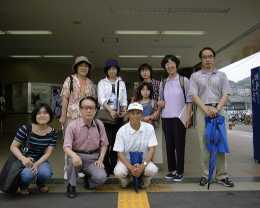 |
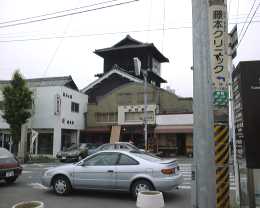 |
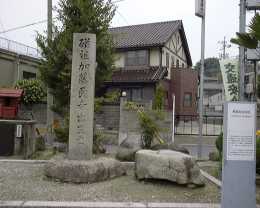 |
| 窯神神社 登り窯を象っている (神社の歴史と拝殿前の狛犬) Kmagami Shrine symbolizing climbing kiln (History of this shrine and Guardian dogs) |
窯神神社 加藤唐左衛門(注2) (2002年6月8日) Kamagami Shrine Kato Touzaemon(Note2) ( June 8, 2002) |
窯神神社 磁祖加藤民吉(注3) Kamagami Shrine Founder of Seto ceramics, Kato Tamikichi (Note3) |
 |
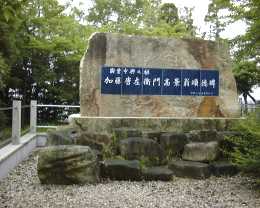 |
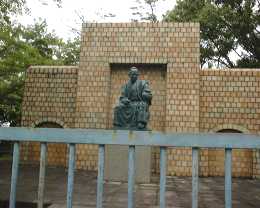 |
| 窯神神社 津金文左衛門胤臣父子の碑(注4) Kamagami Shrine Stone monument for Tsugane Bunzaemon and his son |
陶枕(窯神神社東出口すぐの 民家の庭の周囲)(注5) Ceramic pillows (Note 5) |
窯柱(窯の壁を構成する物: 窯神神社から無風庵へ行く途中の 民家で利用) Materials for kiln used for foundation of building |
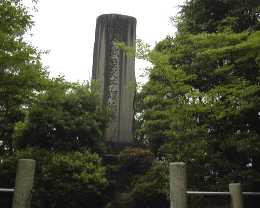 |
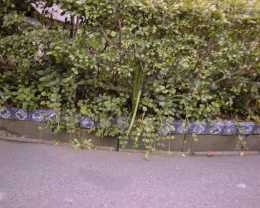 |
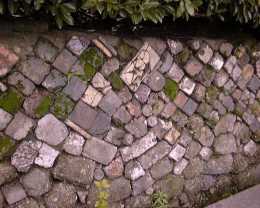 |
| 椋(樹齢約200年?: 窯神神社から無風庵へ行く途中) Tree called Muku (had been used to carry Seto ware on the shoulder) |
江戸時代に瀬戸村と称した一帯 (椋から南を見る) Area called Seto village in Edo era about 400 years ago (viewing south from tree, Muku) |
ツク、エンゴロ、エブタで 作られた塀(加藤滝川陶房: 裏に古狭間窯有り) Fence made by shelf-supports, saggers and sugger boards (There is Old kiln called 'Kohazamagama' at the backyard). |
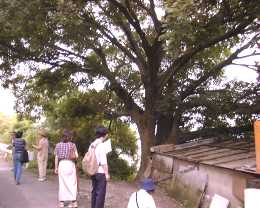 |
 |
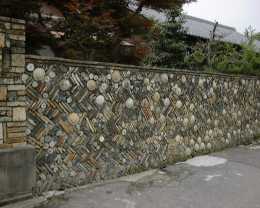 |
| 殉国慰霊塔と移設中の無風庵 (注6) War memorial for people laying down the life for the country and Mufuuan (Note 6) 写真をクリックすると移築完了した 無風庵の写真へジャンプします (2002年6月10日追加) Jumped to Mufuuan when clicking picture |
無風庵から法雲寺への途中の 下り坂 Downward slope to Houunji Temple from Mufuuan |
下り坂の崖崩れ防止用に 焼き不良の陶器が 利用されている Inferior burned ceramics used to avoid landslide |
 |
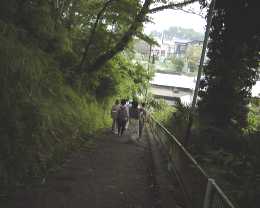 |
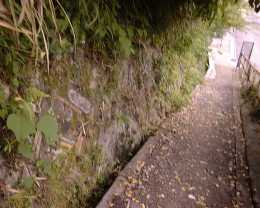 |
| 注1 | 望楼付き陶器店 約75年前、犬山城家老成瀬氏が屋根を犬山城の天守閣に模してこの建物を造り、国府氏が買い取った。 Ceramics shop with a watchtower. Chief retainer of Inuyama Castle, Mr. Naruse built this building with the roof trying to copy from the donjon or castle tower about 75 years ago. After that, Mr. Kokufu bought it as a ceramics shp. |
| 注2 | 加藤唐左衛門 (江戸時代の尾張藩内の政商)(参考HP) 加藤民吉が九州有田で学んだ技法に基づき製造した陶磁器を江戸初め全国への販売ルートに乗せた。 Kato Tosaemon (Businessman with political contacts in the domain of Owari (Aichi Pref. at present) in Edo era (1642-1868). He expanded the sale of porcelains manufacvtured on basis of the technology Kato Tamikichi learned in Kyushu district nationwide. |
| 注3 | 加藤民吉(せともの祭りに雨が降る背後にある逸話 -
2002年6月11日記す) 熊本県天草の東向寺の住職天中和尚(現在の瀬戸市菱野町出身)は高浜焼の染付秘法を得ようとする 民吉を高浜焼窯元上田宜珍に紹介し、様々に便宜をはかった。 身の危険を感じながら、最終的には有田佐々村の市の瀬鴨川の窯焼福本仁左衛門が釉薬その他の 製法を詳しく伝授してくれた。目的を果たした彼は妻に因果を含めて文化四年(一八○七)単身この地を 去った。彼は帰途長崎から天草に寄って東向寺を訪れて厚く謝した後、上田家へ参上し先に欺いて 去った無礼を深く詫びてから自分の素姓と目的を明かしたのである。それを聞いて却って感動した上田は 自家秘伝の赤絵付けの法を伝授したといわれている。(参考HP) Kato Tamikichi - [Anecdote streaming on the background "It rains in Setomono Festival."] Chief priest of Toukouji Temple in Kumamoto, Kyushu was from Seto, and afforded various facility to Tamikichi and introduced him to Mr. Ueda who was potter of Takahama-style ceramics ware. Although facing the risk of his life, he finally learned the manufacturing, glazing or the other technique thanks to Mr. Nizaemon Fukumoto who was potter in Arita, Kyushu. Attaining his aim, he explained his wife the reason, leaving for Seto by himself in 1807. On the way back to Seto, he droppe in Toukouji temple in Amakusa, Kumamoto to express sincere thanks, and then went to Ueda familly to appologized for his deceiving and leaving, and disclosed his identity and aim. Mr. Ueda was impressed with his disclosure and taught Tamikichi his family's secret manner of glazing called 'Akaetuke'. (See a web page for reference) |
| 注4 | 熱田奉行 津金文左衛門胤臣 当時瀬戸村では長男が窯元を継ぐ慣わしだった為、次男であった民吉は父加藤吉左衛門と一緒に熱田 (今の名古屋市熱田区)で農民として生計を計るべく百姓仕事を選んだ。 尾張国熱田新田の開墾奉行だった津金文左衛門胤臣が新田の開墾地を巡視中に鍬使いがとても 下手な一団の人夫がいるので、尋問で素性がわかり奉行の公私にわたる援助のお陰で親子共々、 陶器の研究に精を出せるようになった。民吉の恩人。(参考HP) Atsuta magistrate, Mr. Tsugami Bunzaemon Taneomi It was customary that the eldest son succeed to his family's pottery in Seto in those days. So, Tamikichi chose to make a living as a farmer in Atsuta (Nagoya at present). Mr. Tsugane was magistrate in charge of cultivating new field in Atsuta, and saw a group of farmers who were very inferior at use of plows during his patrol, asking for their idendification. The magistrate showed keen interest on them and supported them both officially and privately in order for them to be able to study ceramics. He was a person truly to whom Tamikichi owed his life. (See a web page for reference) |
| 注5 | 陶枕 陶器の枕。 現在は使われなくなりました。 Ceramic pillows These are not used. |
| 注6 | 無風庵(写真奥に見える萱葺きの建物) 藤井達吉は愛知県が生んだ偉大な芸術家で愛知県碧海郡棚尾村(現碧南市)に父忠三郎・母かぎの 三男として生まれました。 彼が小原村で開いていた塾が無風庵で塾生に多くの瀬戸の陶芸家が いたので小原村ではなく、瀬戸にその庵が移築されることになった。 (詳細は藤井達吉の作品紹介参照) Mufuuan (building with thatched roof) Mr. Tatsukichi Fujii is one of great artists in Aichi. He run a cramming school called 'Mufuuan' in Obara village where many ceramic artists from Seto gathered. Therefore, Mufuuan has been dismantled and reconstructed in Seto, not in Obara village. (See 'Introducton of work by Mr. Tatsukichi Fujii' for details.) |